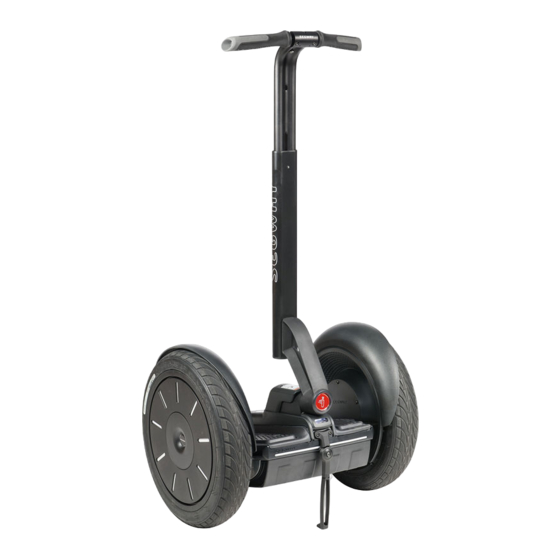
Segway i2 Training Manual
Personal transporter
Hide thumbs
Also See for i2:
- Preventive maintenance manual (13 pages) ,
- Maintenance manual (12 pages) ,
- Installation instructions manual (52 pages)
Table of Contents
Advertisement
Quick Links
The Segway i2 Personal Transporter
Training Packet
INTRODUCTION
Much of the technology in the Segway i2 – notably, how the machine manages to stay upright by
itself (thanks to a Segway-patented process) - is unchanged from the older Segway model (the
i167). There are three main differences:
1) The key.
The InfoKey Controller is essentially an electronic remote for operating the i2; it is also a
display panel. It not only turns the Segway on and off, but also shows and monitors a variety
of information. It can be docked on the vehicle or carried separately. On the older Segway,
the display screen is attached to the handlebar frame, and the key is separate (actually, there
are several different keys, for different speeds – we only ever use the "slow" key).
2) The batteries.
The i2 uses lithium-ion batteries, whereas our older model uses nickel metal hydride
batteries. These Li-ion batteries charge more quickly and retain a charge longer. The i2 can
go up to 24 miles (38km) or 480 city blocks with fully-charged batteries. (The maximum
distance achieved will depend on terrain, weight of rider, and riding style.) The older
Segway can travel at most up to 12 miles on a full charge.
3) The handle and turning mechanism.
The handlebar on the i2 tilts and pivots from the base, using what is called LeanSteer
technology: you move the handlebar frame in the direction you want to turn, and the Segway
turns. The frame is highly responsive; a gentle tilt is sufficient to get the machine to turn.
Maneuvering when riding is intuitive: lean forward to go forward, lean back to move
backwards, and lean the frame to either side to turn in that direction. On the older model,
you need to rotate a knob on the handle to turn in either direction; the frame is rigid. Like the
older model, the i2 can rotate around a single axis (by the wheels turning in opposite
directions), giving the Segway a turning radius of zero.
The basic i2 without any added accessories costs about $5,100. (The x2, a cross-terrain version
that can maneuver through dirt, gravel, grass, etc., costs about $5,700 without accessories.)
Primary users for the Segway - other than technology- and gadget-loving individuals with money
to spend - are police departments and security agencies on college campuses and in airports,
railway stations, manufacturing facilities, and shopping malls. Segways are also being used in
cargo warehouses and at various resorts and golf courses.
1
Advertisement
Table of Contents

Subscribe to Our Youtube Channel
Summary of Contents for Segway i2
- Page 1 Training Packet INTRODUCTION Much of the technology in the Segway i2 – notably, how the machine manages to stay upright by itself (thanks to a Segway-patented process) - is unchanged from the older Segway model (the i167). There are three main differences: 1) The key.
-
Page 2: How It Works
EDUCATIONAL GOALS The purpose when demonstrating the Segway i2 for visitors is the same as for the older model: compare how the human body balances and moves with how this machine does it. As the Segway literature explains: “If you stand up and lean forward so that you are out of balance, you probably won't fall on your face. -
Page 3: Using The Key
In addition, the Segway has two tilt sensors filled with electrolyte fluid. Like your inner ear, these sensors determine their position relative to the ground based on the angle at which the surface of the fluid tilts. - Page 4 Balance indicator lights flash, and information will appear on the display screen (including a happy face icon). You can turn the i2 on from a distance, or wait to dock the key in its base (preferable, so that you don’t misplace the key). However, make sure not to turn on the power until you have unplugged the machine from the wall;...
-
Page 5: Getting On And Off
Once you see only the green light, place one foot on the Segway mat and press down (but do not step on) – the machine will beep and roll slightly, and all 5 lights will illuminate in green. This tells you that you are now in Balance mode. - Page 6 InfoKey display screen will turn off. Take the key out of the dock (remember to hold the clip down to release the key), and return it to the cup in the walkie cabinet. Plug the Segway back into the wall. Make sure that the battery lights come on after you plug in the cord – if they don’t, check to make sure the plug is in properly.
-
Page 7: Battery Charging
If there are NO solid bars, do not try to ride the Segway! If the battery charge becomes too low while you are riding, a warning tone will be emitted and an unhappy face displayed on the screen. If you receive this warning, you should come to a controlled stop and step off the machine. -
Page 8: Specifications
* Note: although Li-ion batteries are available for the i167 model, our Segway does not have them (with such batteries, the range for that model would be similar to the i2’s range). ** Weighing less than this is a safety hazard, because the rider may not be able to shift his or her...















Need help?
Do you have a question about the i2 and is the answer not in the manual?
Questions and answers